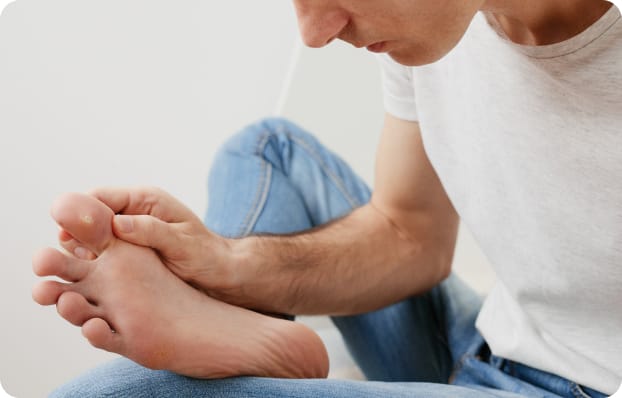Plantar Wart
A plantar wart (verruca plantaris, VP; also commonly called a verruca) is a wart caused by the human papilloma virus (HPV). It is a small lesion that appears on the sole of the foot (hence the name, from Latin planta pedis, the sole of the foot) and typically resembles a cauliflower. A plantar wart may have small black specks within it that ooze blood when the surface is cut or shaved; these are abnormal capillaries. Though the name plantar wart describes specifically HPV infection on the sole of the foot, infection by the virus is possible anywhere on the body and common especially on the palm of the hand, where the appearance of the wart is often exactly as described above for plantar warts. Because of pressure on the sole of the foot, a layer of hard skin forms over the wart. A plantar wart may or may not be painful. It can be spread in communal showers, around swimming pools, by sharing shoes, etc.


Diagnosis
Plantar warts, can often be differentiated from helomata, corns, by close observation of skin striations. Feet, like hands, are covered in skin striae, which are more commonly called fingerprints. With plantar warts, the skin striae go around the lesion; if the lesion is not a plantar wart, the cells’ DNA is not altered and the striations continue across the top layer of the skin. Plantar warts tend to be painful on application of pressure from either side of the lesion rather than direct pressure. Helomata tend to be painful on direct pressure rather than pressure from either side.
The difference between plantar warts and warts elsewhere on the body is that warts are generally outgrowth lesions, but on the bottom of the foot, they are pushed inward by the pressure of walking. Since the skin on the bottom of the foot tends to be thicker than elsewhere, the treatment of plantar warts is more difficult.
Treatment
No treatment in common use is 100% effective. The most comprehensive medical review found that no treatment method was more than 73% effective and using a placebo had a 27% average success rate. The American Family Physician recommends:

First-line therapy
Over the counter salicylic acid

Second-line therapy
Cryosurgery, intralesional immunotherapy, or pulsed dye laser therapy

Third-line therapy
Bleomycin, surgical excision
Podiatrists and dermatologists are considered specialists in the treatment of plantar warts, though most warts are treated by primary care physicians.
Vaccination
Although immunization is available for the HPV and strains causing cervical cancer and venereal warts, there is currently no vaccination treatment for plantar warts.
Pharmacologic Rx

Keratolytic Chemicals

Immunotherapy

Chemotherapy
Topical application of dilute glutaraldehyde (a virucidal chemical, used for cold sterilization of surgical instruments) is an older effective wart treatment. More modern chemotherapy agents, like 5-fluoro-uracil, are also effective topically or injected intralesionally. Retinoids, systemically (eg. isotretinoin) or topically (tretinoin cream) may be effective.
As warts are contagious, precautions should be taken to avoid spreading.
Surgical




Other




Relative Effectiveness Of Treatments
A 2006 study assessed the effects of different local treatments for cutaneous, non-genital warts in healthy people.The study reviewed 60 randomized clinical trials dating up to March 2005. The main findings were:

Overall there is a lack of evidence (many trials were excluded because of poor methodology and reporting).

The average cure rate using a placebo was 27% after an average period of 15 weeks.

The best treatments are those containing salicylic acid. They are clearly better than placebo.

There is surprisingly little evidence for the absolute efficacy of cryotherapy.

Two trials comparing salicylic acid and cryotherapy showed no significant difference in efficacy.

One trial comparing salicylic acid and duct tape occlusion therapy showed no significant difference in efficacy.

Evidence for the efficacy of the remaining treatments was limited.
Complications
Warts may spread, develop into clusters or fuse to become a mosaic wart. Plantar warts can be painful making it difficult to walk and run. Over-aggressive treatment may lead to scarring. Others may be infected. If a wart is being treated professionally and does not seem to improve in a reasonable period of time, the growth should be excised and biopsied.
Prevention
Avoid walking barefoot in public areas such as showers, communal changing rooms. (Covering with an adhesive bandage is not a safe method as it will not last for long at all, especially while showering or swimming)
Change shoes and socks daily.
Avoid sharing shoes and socks.
Avoid direct contact with warts on other parts of body.
Avoid direct contact with warts on other persons.

